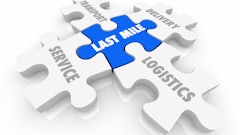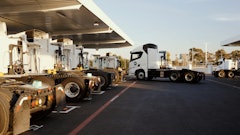TRANSPORTATION OPTIMIZATION
Leverage Technology
Today’s advanced technology solutions can offer manufacturers, distributors and retailers relief for many of the transportation “pain points,” including rising fuel costs, ongoing driver shortages, increased safety and security concerns and hours of service requirements.
Dynamic transportation execution. Transportation execution is where the rubber meets the road, as shippers carry out their strategic plans through month-to-month, week-to-week and sometimes day-to-day tactical decision-making. Advanced technology solutions make it easier for shippers to manage their transportation networks smoothly and efficiently. New optimization algorithms make it possible to evaluate and compare multiple transportation modes, routings and service levels, and to quickly source additional capacity should that become necessary.
Shippers seeking to optimize their transportation execution processes let technology do the “heavy lifting.” Keeping track of the relative costs of different transportation modes, as well as the relative costs of each carrier option, is critical in today’s environment of fluctuating rates and accessorial charges. A good transportation management system will evaluate the relative costs and service levels of every transportation option, and make recommendations that are optimal for the shipper’s defined business goals.
Real-time carrier communications. At today’s speed of business, enabling real-time communication solutions, such as EDI (electronic data interchange) and Web-based solutions, is critical for keeping in touch with trading partners, customers and transportation providers. Whether considering bid offers and counter-offers, negotiating contracts, communicating load details to carriers or seeking carrier capacity for a distressed shipment, the days of “dialing for diesels” and spending hours sending phone or fax messages and awaiting responses are over. Instead, fast, efficient system-to-system communication with a variety of carriers has proven to be the most effective way to expedite fulfillment requirements.
Rapid two-way communication is also essential to handle unforeseen events, such as supplier or shipment delays, before they become a problem. With real-time communications, you can also support advanced execution processes such as spot bidding, spot capacity, yard management and appointment scheduling.
Streamlining communications and collaborating closely with carrier partners are proven strategies for improving workflow synchronization, negotiating cost-effective contracts and maintaining desired rates of fulfillment performance. The faster you can get your load tenders into the carriers’ systems, the more likely you will get the trucks you need when you need them.
Performance tracking, measurement and analysis. What you cannot measure, your carriers will not improve. Performance management technology tools enable shippers to monitor and measure the performance of transportation providers and use that information as a basis for future carrier selection decisions.
Keeping scorecards on carrier performance through analysis of current and historical data is a sound business practice that will pay dividends in the efficiency and quality of service levels.
Shippers striving for continuous improvement should also benchmark and periodically measure the effectiveness of their own internal processes relative to velocity, throughput and profitability. The success or failure of a strategic transportation plan is just as dependent on your own ability as a shipper to follow the plan as it is for your carriers to perform at the levels to which they committed.
—Prashant Bhatia, senior director, product management, Manhattan Associates Inc., Atlanta.
Use The Internet
Increasing numbers of small and mid-sized businesses are evaluating the benefits of using a hosted solution for fleet technology to ease the headaches of managing complex software packages. Businesses are becoming receptive to the idea of using an application service provider (ASP) to deliver a solution they can use anytime, anywhere over the Internet.
Think of it as turning the information technology that runs your fleet into an on-demand, just-in-time stream—only what you need, when you need it. No longer must the customer bear the brunt of major technology risk associated with large IT asset investments. Web-based fleet management lets you deploy applications that benefit your business faster at a lower total cost. It lets you focus on your core business—delivering for your business—while ensuring you’re paying only for what you need, when you need it.
Some of the top reasons for your company to consider the ASP approach are:
The business objective for using a hosted solution is to move past simple automation to a higher level of business intelligence without the cost, complexity and concerns associated with software. —Tom Flies, vice president, business development, XATA Corp., Minneapolis.
Don't Get Tanked
With fuel prices climbing to record highs, companies are looking for ways to save at the pump. To help keep costs down, International Truck & Engine Corp., Warrenville, IA, offers these tips for getting the most miles out of a tank of fuel. It starts before you even hit the road, as a well-maintained truck means a more fuel-efficient vehicle:
Check and replace air filters regularly: Replacing a clogged air filter can improve a vehicle’s fuel mileage by as much as 10 percent. The air filter keeps impurities from damaging the inside of your engine. Not only will replacing a dirty air filter save on fuel, but also it will protect your engine;
Keep tires properly inflated :Check tire pressure weekly to maintain optimum air pressure and to make sure the wheels are in alignment to prevent tires from dragging. This can improve mileage by around 3.3 percent. Under-inflated tires can lower fuel mileage by 0.4 percent for every one pound-per-square-inch drop in pressure of all four tires. Properly inflated tires are safer and last longer. Tires are the most fuel-efficient in the second half of their life when some of the tread is worn down. Also, radials can return up to 8 percent fuel economy over bias tires;
Avoid aggressive driving: Aggressive driving (speeding, accelerating or braking too quickly) wastes fuel. It can lower mileage by up to 33 percent at highway speeds and by 5 percent during city driving. Sensible driving is always recommended for on-road safety;
Observe the speed limit: Fuel mileage decreases rapidly at speeds above 60 miles per hour. Each 5 miles per hour you drive in excess of 60 miles per hour can translate to an additional 10 cents per gallon. The difference between driving 65 miles per hour and 75 miles per hour could easily result in 1-2 miles per gallon difference under many circumstances. Observing the speed limit is also another way to stay safe;
Avoid excessive idling: Idling gets 0 miles per gallon. Vehicles with larger engines typically waste more fuel at idle than do vehicles with smaller engines. To limit idle time, it is always better to turn the engine off at each stop than to leave it running. The longer the vehicle idles, the more fuel it burns.
Increase Payload
There is a critical balance between profitability, safety and customer service, so it is important to choose a transportation partner that will help you get the best payload possible, keep your product safe and offer excellent customer service.
One way to guarantee better profits is to choose a company that has both specialized equipment and high safety standards while continually working with you to ensure that your transportation needs are growing along with your company.
The federal highway system allows a truck traveling on the roads a maximum weight of 80,000 pounds no matter what product is being transported. Therefore, if you can develop a lighter truck and trailer, a larger payload can be delivered to the end user.
It has always been a best practice of Ruan for its engineers to work directly with manufacturers and customers to develop specialized equipment. More than 10 years ago, when Ruan began working with Michael Foods, based in Minnetonka, MN, our engineers immediately began working with manufacturers to develop a lighter truck and trailer. Michael Foods is one of the country’s largest shippers and consumers of eggs. In Iowa and Nebraska, Michael Foods ships more than 30 loads of liquid eggs per day. Each liquid load is equal to approximately 480,000 eggs.
Ruan designed a lightweight day cab tractor that weighs less than 14,500 pounds with a driver and full of fuel. The trailer was de- signed with all lightweight components and built to be shell full at 6,300 gallons.
Ten to 15 years ago, 45,000-47,000 pounds of product was considered to be a good-sized shipment. Today, Ruan trucks, properly designed, haul approximately 54,000 pounds of product. For example, if a shipment costs $500 to move, 45,000 pounds would cost a company $111 per hundredweight (CWT). When you increase the weight to 54,000 pounds, you decrease your CWT to $92, which is a 20 percent freight savings. —Mike Mefford, vice president, sales, Ruan Transportation Management Systems, Des Moines, IA.


























